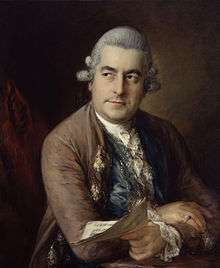Johann Christian Bach

Johann Christian Bach (September 5, 1735 – January 1, 1782) was a composer of the Classical era, the eleventh surviving child and youngest son of Johann Sebastian Bach. He is sometimes referred to as "the London Bach" or "the English Bach", due to his time spent living in the British capital, where he came to be known as John Bach.[1] He is noted for influencing the concerto style of Mozart.
Life
Johann Christian Bach was born to Johann Sebastian and Anna Magdalena Bach in Leipzig, Germany. His distinguished father was already 50 at the time of his birth- an age gap exemplified by the sharp differences in the musical styles of father and son. Even so, father Bach instructed Johann Christian in music until his death in 1750. After his father's death, he worked (and lived) with his second-oldest half brother Carl Philipp Emanuel Bach, who was twenty-one years his senior and considered at the time to be the most musically gifted of Bach's sons.
He enjoyed a promising career, first as a composer then as a performer playing alongside Carl Friedrich Abel, the notable player of the viola da gamba. He composed cantatas, chamber music, keyboard and orchestral works, operas and symphonies.
St Pancras Churchyard, London
Bach lived in Italy for many years starting in 1756, studying with Padre Martini in Bologna. He became organist at the Milan cathedral in 1760. During his time in Italy, he converted from Lutheranism to Catholicism and devoted much time to the composition of church music, including two Masses, a Requiem and a Te Deum.[2] His first major work was a Mass, which received an excellent performance and acclaim in 1757.[2] In 1762, Bach travelled to London to première three operas at the King's Theatre, including Orione on 19 February 1763. That established his reputation in England, and he became music master to Queen Charlotte. In 1766, Bach met soprano Cecilia Grassi, who was eleven years his junior, and married her shortly thereafter. They had no children.
By the late 1770s, both his popularity and finances were in decline. By the time of Bach's death on New Year's day 1782,[3] he had become so indebted (in part due to his steward embezzling his money), that Queen Charlotte stepped in to cover the expenses of the estate and provided a life pension for Bach's widow. He was buried in the graveyard of St. Pancras Old Church, London.
Legacy
 |
Sinfonia in G minor, Op. 6, No. 6
I. Allegro Performed by Camerata Budapest, Hanspeter Gmur (conductor), courtesy of Naxos Records |
| Problems playing this file? See media help. | |
A full account of J. C. Bach's career is given in the fourth volume of Charles Burney's History of Music.
There are two others named Johann Christian Bach in the Bach family tree, but neither was a composer.
Mozart, when aged 8, met Johann Christian Bach in London and became an admirer of his music. Mozart arranged three sonatas from the latter's Op. 5 into keyboard concertos. In later life Mozart "often acknowledged the artistic debt he owed" to Johann Christian.[4]
Works
The works of JC Bach are given 'W' numbers, from Ernest Warburton's Thematic catalog of his works (New York City: Garland Publishing, 1999).
References
Notes
- ↑ Eric Siblin The Cello Suites: J. S. Bach, Pablo Casals, and the Search for a ... 2011, p. 234. "Known as the 'London Bach', he travelled to Italy, converted to Roman Catholicism, and enjoyed celebrity status in England, going by the name John Bach. Only fourteen years old when Bach died, Johann Christian apparently occupied a ..."
- 1 2 "The Catholic Bach", Cantica Nova Publications
- ↑ Stephenson, Joseph. Johann Christian Bach at AllMusic
- ↑ Denis Arnold and Basil Smallman, "Bach family", in Oxford Companion to Music, ed. Alison Latham, Oxford University Press, 2002, p. 80. ISBN 978-0-19-866212-9
Sources
- Hans T. David, A. Mendel, C. Wolff. The New Bach Reader: A Life of Johann Sebastian Bach in Letters and Documents (NY: Norton, 1998).
- Heinz Gärtner (trans. by Reinhard Pauly). John Christian Bach: Mozart's Friend and Mentor. (Portland, Oregon: Amadeus Press, 1994).
- Philipp Spitta (trans. by Clara Bell & J. A. Fuller-Maitland). Johann Sebastian Bach, his work and influence on the music of Germany, 1685–1750, 3 vols. (London: Novello & Co., 1899): Vol I, Vol II, Vol III
- Charles Sanford Terry. John Christian Bach (London: Oxford University Press, 1967).
- Christoph Wolff et al. The New Grove Bach Family. (NY: Norton, 1983) pp. 315ff. ISBN 0-393-30088-9.
- Percy M. Young. The Bachs: 1500–1850 (London: J.M. Dent & Sons, Ltd., 1970).
External links
| Wikimedia Commons has media related to Johann Christian Bach. |
Information
- J C Bach (classical.net)
- J C Bach (classicalarchives.com)
- J C Bach (pianosociety.com)
- Article: "Gainsborough and Music" by Brian Robins
Music
- Free scores by Johann Christian Bach at the International Music Score Library Project (IMSLP)
- Piano sonatas Op. 17, 1–6 on YouTube
- Concerto in D major, Op. 13, No. 2, 1st movement on YouTube
- Quartet in B-flat major on YouTube
- Flute sonatas, W. B 10–15, 1780 edition (From the Sibley Music Library Digital Scores Collection)